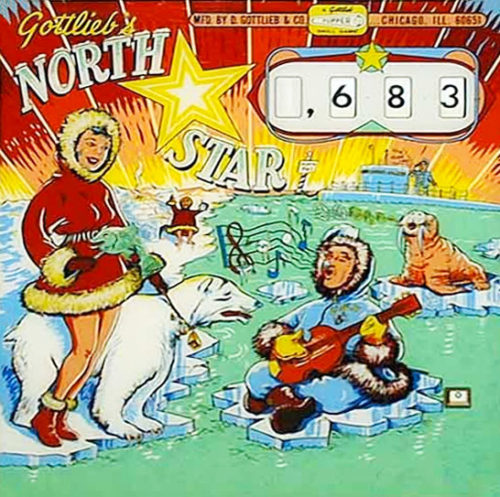-
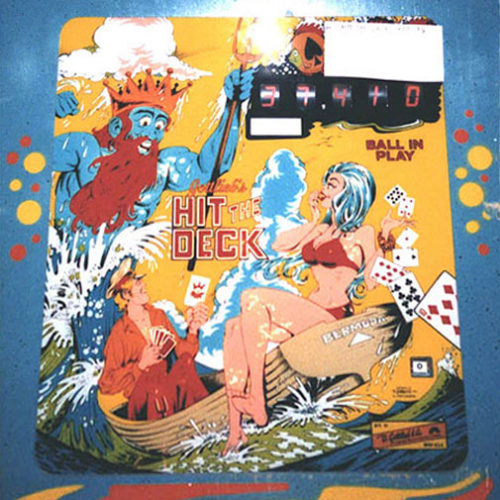
-
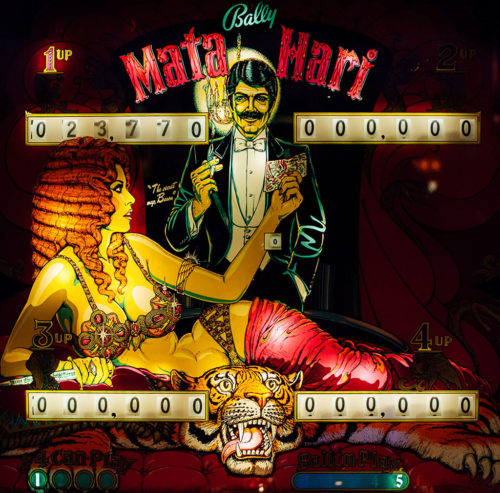 Mata Hari was released in April of the year and designed by Jim Patla with artwork accolades going to Dave Christiansen. 16,200 of these machines were produced in the new solid-state format (as seen in the museum) as well as bunch of electromechanical machines (170, to be exact) to keep the non-computer savvy operators happy and buying machines they knew how to fix. This machine before you is one of the finest examples of this ultra-rare mechanical format. Like the solid-state version, the center kickout hole scores 3,000 points and each successful shot in the hole advances the bonus multiplier. The A and B skill shots advance the horizontal sequence of increasing values in the center of the playfield. 50,000 points are awarded when a battery of drop targets is hit. If both batteries are knocked down, the drop targets reset and hitting all again awards the replay. Score is another replay option.
Mata Hari was released in April of the year and designed by Jim Patla with artwork accolades going to Dave Christiansen. 16,200 of these machines were produced in the new solid-state format (as seen in the museum) as well as bunch of electromechanical machines (170, to be exact) to keep the non-computer savvy operators happy and buying machines they knew how to fix. This machine before you is one of the finest examples of this ultra-rare mechanical format. Like the solid-state version, the center kickout hole scores 3,000 points and each successful shot in the hole advances the bonus multiplier. The A and B skill shots advance the horizontal sequence of increasing values in the center of the playfield. 50,000 points are awarded when a battery of drop targets is hit. If both batteries are knocked down, the drop targets reset and hitting all again awards the replay. Score is another replay option. -
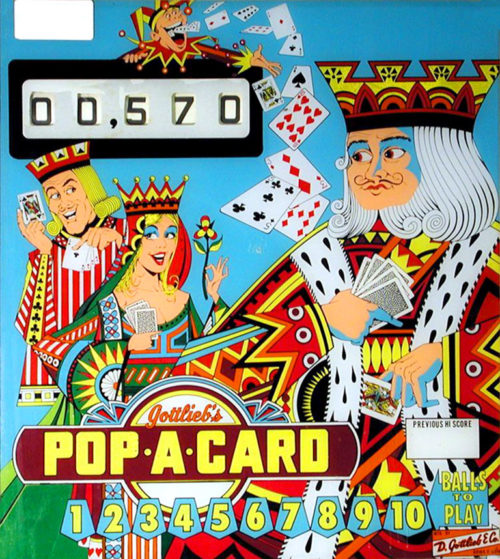 Gottlieb Pop-A-Card was another classic ‘70s playfield designed by Ed Krynski with artwork by Gordon Morison. Only 825 of these units were made. The replay version of the game was called Drop–A-Card which, as usual, was a much higher produced machine. The open playfield of this game gives ample room for scoring the three banks of drop targets. To win free balls with this game, you have to either complete the 2, 3, 4, and 5 targets, or the 6, 7, 8, and 9 targets…or the 10, J, Q, K, and Ace targets. The first two options light the wow feature to award free balls during that ball in play. If you hit the 10 thru Ace targets to completion, four rollovers light up to score extra balls. Of course, score is another way to score more balls.
Gottlieb Pop-A-Card was another classic ‘70s playfield designed by Ed Krynski with artwork by Gordon Morison. Only 825 of these units were made. The replay version of the game was called Drop–A-Card which, as usual, was a much higher produced machine. The open playfield of this game gives ample room for scoring the three banks of drop targets. To win free balls with this game, you have to either complete the 2, 3, 4, and 5 targets, or the 6, 7, 8, and 9 targets…or the 10, J, Q, K, and Ace targets. The first two options light the wow feature to award free balls during that ball in play. If you hit the 10 thru Ace targets to completion, four rollovers light up to score extra balls. Of course, score is another way to score more balls. -
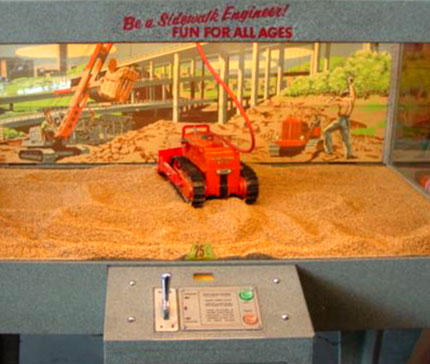 This Williams machine fabricated in 1955 is a strange game that really is more of a toy. A player gets to operate a remote-controlled bulldozer around a big sandbox for 120 seconds using two remote controllers in synthetic gravel. It appears the idea for this machine was to cater to the under-12 market as no rewards, extra time, or extra plays were programmed into the electromechanical boards within the machine. No scoring and no prizes! This machine was often confused with Williams’ Crane (1956) because it has a sign on top of the game that says, “Be a sidewalk engineer.” Ten cents allowed adults a two-minute break to get a quick snack while a child was entertained. I don’t think this would be the case in today’s thinking…
This Williams machine fabricated in 1955 is a strange game that really is more of a toy. A player gets to operate a remote-controlled bulldozer around a big sandbox for 120 seconds using two remote controllers in synthetic gravel. It appears the idea for this machine was to cater to the under-12 market as no rewards, extra time, or extra plays were programmed into the electromechanical boards within the machine. No scoring and no prizes! This machine was often confused with Williams’ Crane (1956) because it has a sign on top of the game that says, “Be a sidewalk engineer.” Ten cents allowed adults a two-minute break to get a quick snack while a child was entertained. I don’t think this would be the case in today’s thinking… -
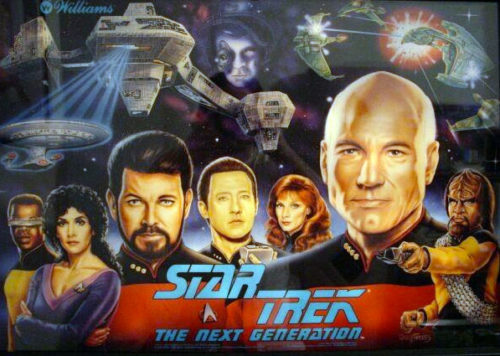 Star Trek: The Next Generation is a widebody pinball game, designed by Steve Ritchie and released in November 1993 by Williams Electronics. It was part of WMS’ SuperPin series (see also The Twilight Zone and Indiana Jones: The Pinball Adventure), and was based on the TV series. It is the only pinball machine that features three separate highscore-lists. Apart from the regular highscore-list and the buy-in-list, it also features a reminiscence to The Machine: Bride of Pin*Bot billionaires club. It is also the third pinball game overall based on the Star Trek franchise, following the 1979 pinball game by Bally, and the 1991 game by Data East (both based on the original series). Launch options When a new ball is launched into the plunger, the player is given one of five launch awards, which is selected when the ball is fired. Unless otherwise noted, the ball is launched through the spiral ramp and into the lock hole (above the pop bumpers). Another ball is popped from the left scoop and onto the left inlanes. Start Mission: Starts lit mission. Flipper Skill Shot: The player has to shoot the ball up the right ramp (the Beta Quadrant) for a random award. Launch Probe: The ball will be loaded into one of the two cannons, located on top of the slings. Shoot the lit target for a random award. If the player misses, Data will say, “The probe has discovered nothing, sir”. Light Lock / Light Holodeck: Lights the ball lock, and the ball gets locked for multiball. When this option is selected twice, “Light Lock” changes to “Light Holodeck”. Warp Factor: Starts the ball at Warp Factor 4. After the player reaches Warp 9, (depending on the ROM version), the award changes to Warp 9.1, up to 9.9 (the player has only a limited amount of time to make either the left circle or Delta ramp for each point), then changes to “Warp Factor 2″. The ball is sent to the pop bumpers. Scoring and Game Modes There are several ways to score points outside of the missions as well as unlocking certain game modes. The following modes are available: Explosive Millions – Shooting the Alpha Quadrant or Beta Quadrant ramps unlocks Explosive Millions. Shooting the same or opposite ramp awards 5 million points, followed by 10 million for another shot, which cumuliates by 10 million every shot. The player has ten seconds to hit the ramp to score or the mode ends. Bonus Multipliers – Hitting all three rollover lanes above the bumpers will increase the bonus multiplier for that ball. The first completion raises it to 2X, and subsequent steps raise it 2X at a time to a maximum of 10X. When the 8X is achieved, the Extra Ball light is lit in the “Start Mission” pocket. When the multiplier is maxed, completing the rollovers again awards 10 million, with the value increasing by 10 million every time afterward Holodeck – The player has two choices. Score 25 million points, or play the “video mode” shuttle cavern. If the player selects the video mode, the player has to go through the caverns in a shuttle, picking up 10 million point cards while avoiding mines and cavern walls. There is an extra ball card somewhere in the caverns, as well as artifact (see below). Reaching the Extra Ball is achieved by alternating Left, Left, Right, Right turns until cavern 7. Depending on how many Extra Balls have already been earned and the games Extra Ball probability configuration it may end up either an Extra Ball or a 10 million point card. Once an Extra Ball has been earned in the Holodeck all subsequent Holodeck runs will not award any Extra Balls, regardless of the path chosen. Collecting the artifact, clearing all caverns, or crashing into a mine or wall immediately ends the video mode scoring the points collected in the mode. A maximum score of 159 million points is possible for a flawless run. At the start of the Holodeck mode, pressing a flipper button along with pulling the launch trigger starts a “Riker’s Poker Night” video mode. Kickback – Shooting the three left yellow targets lights Kickback, which saves the ball from draining from the left outlane. If the game is in tournament mode this must initially be earned. Otherwise the game starts out with the Kickback lit. The Kickback can be recharged unlimited times by hitting the appropriate targets after it had been depleted. Shuttle Ramp – Each shot at the Beta Quadrant Ramp launches a shuttle which a certain number of launched shuttles can reward a player. Rewards could be Light Holodeck, Command Decision, or Extra Balls. Between the ramps are two small targets when hit, adds two times the shuttle to the counter.
Star Trek: The Next Generation is a widebody pinball game, designed by Steve Ritchie and released in November 1993 by Williams Electronics. It was part of WMS’ SuperPin series (see also The Twilight Zone and Indiana Jones: The Pinball Adventure), and was based on the TV series. It is the only pinball machine that features three separate highscore-lists. Apart from the regular highscore-list and the buy-in-list, it also features a reminiscence to The Machine: Bride of Pin*Bot billionaires club. It is also the third pinball game overall based on the Star Trek franchise, following the 1979 pinball game by Bally, and the 1991 game by Data East (both based on the original series). Launch options When a new ball is launched into the plunger, the player is given one of five launch awards, which is selected when the ball is fired. Unless otherwise noted, the ball is launched through the spiral ramp and into the lock hole (above the pop bumpers). Another ball is popped from the left scoop and onto the left inlanes. Start Mission: Starts lit mission. Flipper Skill Shot: The player has to shoot the ball up the right ramp (the Beta Quadrant) for a random award. Launch Probe: The ball will be loaded into one of the two cannons, located on top of the slings. Shoot the lit target for a random award. If the player misses, Data will say, “The probe has discovered nothing, sir”. Light Lock / Light Holodeck: Lights the ball lock, and the ball gets locked for multiball. When this option is selected twice, “Light Lock” changes to “Light Holodeck”. Warp Factor: Starts the ball at Warp Factor 4. After the player reaches Warp 9, (depending on the ROM version), the award changes to Warp 9.1, up to 9.9 (the player has only a limited amount of time to make either the left circle or Delta ramp for each point), then changes to “Warp Factor 2″. The ball is sent to the pop bumpers. Scoring and Game Modes There are several ways to score points outside of the missions as well as unlocking certain game modes. The following modes are available: Explosive Millions – Shooting the Alpha Quadrant or Beta Quadrant ramps unlocks Explosive Millions. Shooting the same or opposite ramp awards 5 million points, followed by 10 million for another shot, which cumuliates by 10 million every shot. The player has ten seconds to hit the ramp to score or the mode ends. Bonus Multipliers – Hitting all three rollover lanes above the bumpers will increase the bonus multiplier for that ball. The first completion raises it to 2X, and subsequent steps raise it 2X at a time to a maximum of 10X. When the 8X is achieved, the Extra Ball light is lit in the “Start Mission” pocket. When the multiplier is maxed, completing the rollovers again awards 10 million, with the value increasing by 10 million every time afterward Holodeck – The player has two choices. Score 25 million points, or play the “video mode” shuttle cavern. If the player selects the video mode, the player has to go through the caverns in a shuttle, picking up 10 million point cards while avoiding mines and cavern walls. There is an extra ball card somewhere in the caverns, as well as artifact (see below). Reaching the Extra Ball is achieved by alternating Left, Left, Right, Right turns until cavern 7. Depending on how many Extra Balls have already been earned and the games Extra Ball probability configuration it may end up either an Extra Ball or a 10 million point card. Once an Extra Ball has been earned in the Holodeck all subsequent Holodeck runs will not award any Extra Balls, regardless of the path chosen. Collecting the artifact, clearing all caverns, or crashing into a mine or wall immediately ends the video mode scoring the points collected in the mode. A maximum score of 159 million points is possible for a flawless run. At the start of the Holodeck mode, pressing a flipper button along with pulling the launch trigger starts a “Riker’s Poker Night” video mode. Kickback – Shooting the three left yellow targets lights Kickback, which saves the ball from draining from the left outlane. If the game is in tournament mode this must initially be earned. Otherwise the game starts out with the Kickback lit. The Kickback can be recharged unlimited times by hitting the appropriate targets after it had been depleted. Shuttle Ramp – Each shot at the Beta Quadrant Ramp launches a shuttle which a certain number of launched shuttles can reward a player. Rewards could be Light Holodeck, Command Decision, or Extra Balls. Between the ramps are two small targets when hit, adds two times the shuttle to the counter. -
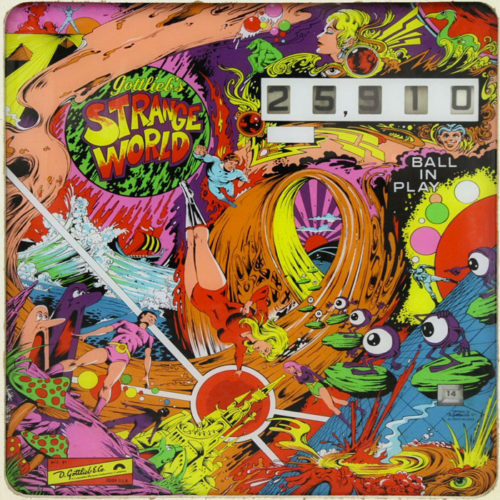
-
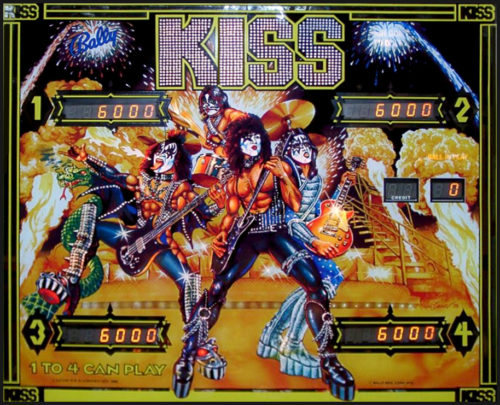
-
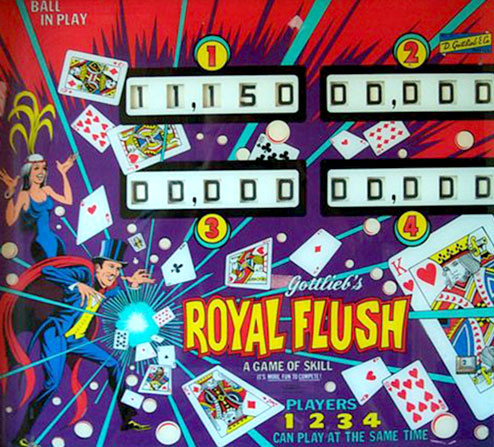 This April release came in a four-player version, also in the museum called “Royal Flush.” 12,250 games were created in this sizable run of machines. Ed Krynski designed the machine with Gordon Morison penning the artwork for the game. A very popular game in its day, the main ingredient of the play field is the battery of nine drop targets set at an angle. The object here is to complete the drop targets to complete the five card combinations represented on the front play field. Completing a combo illuminates the light in the bonus column of combos and at the end of the ball, a “scan” bonus would score the appropriate number of points to the player currently up. The drop targets reset after each ball unless an extra ball is scored via the free ball gate. A double scan of the bonus lights on the last ball. Another feature to shoot for is the three colored card sequence. These light a special on the kick-out hole.
This April release came in a four-player version, also in the museum called “Royal Flush.” 12,250 games were created in this sizable run of machines. Ed Krynski designed the machine with Gordon Morison penning the artwork for the game. A very popular game in its day, the main ingredient of the play field is the battery of nine drop targets set at an angle. The object here is to complete the drop targets to complete the five card combinations represented on the front play field. Completing a combo illuminates the light in the bonus column of combos and at the end of the ball, a “scan” bonus would score the appropriate number of points to the player currently up. The drop targets reset after each ball unless an extra ball is scored via the free ball gate. A double scan of the bonus lights on the last ball. Another feature to shoot for is the three colored card sequence. These light a special on the kick-out hole. -
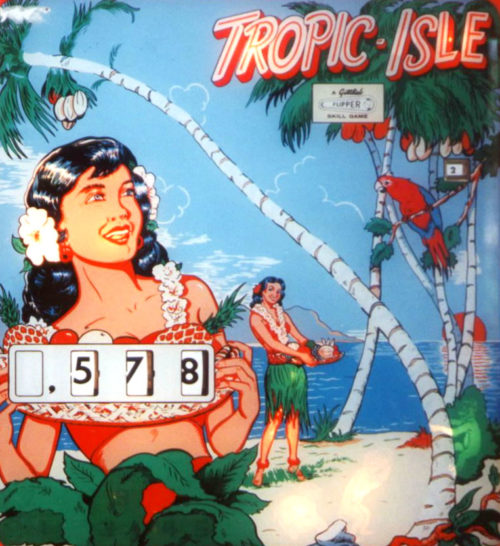 Wayne Neyens designed this classic with Roy Parker penning the artwork. 2,700 of these were fabricated. This game has a holdover feature, which holds the monkeys’ positioning on the backglass from game to game. If you’re skillful enough to hit the A, B, C, and D targets, a monkey is advanced up the tree on the backglass. If one monkey makes it to the top, one replay is awarded: two monkeys score two replays, and three monkeys score three replays. Obviously if you pass this game and notice the third monkey nearing the top, feeding the coin slot was a natural for your just reward. Rolling over the 1 – 5 rollovers at the top of the playfield lights the side specials and awards 200 points once you drain the ball. A nice, well balanced game and quite a challenge not to lose your ball in play.
Wayne Neyens designed this classic with Roy Parker penning the artwork. 2,700 of these were fabricated. This game has a holdover feature, which holds the monkeys’ positioning on the backglass from game to game. If you’re skillful enough to hit the A, B, C, and D targets, a monkey is advanced up the tree on the backglass. If one monkey makes it to the top, one replay is awarded: two monkeys score two replays, and three monkeys score three replays. Obviously if you pass this game and notice the third monkey nearing the top, feeding the coin slot was a natural for your just reward. Rolling over the 1 – 5 rollovers at the top of the playfield lights the side specials and awards 200 points once you drain the ball. A nice, well balanced game and quite a challenge not to lose your ball in play. -
 Donkey Kong is an arcade game released by Nintendo in 1981. It is an early example of the platform game genre, as the gameplay focuses on maneuvering the main character across a series of platforms while dodging and jumping over obstacles. In the game, Jumpman (since renamed Mario) must rescue a damsel in distress, Lady (now named Pauline), from a giant ape named Donkey Kong. The hero and ape later became two of Nintendo’s most popular characters. Donkey Kong is one of the earliest examples of the platform game genre; it is sometimes said to be the first platform game, although it was preceded by Space Panic. In contrast to Space Panic, however, Donkey Kong was the first platform game to feature jumping, introducing the need to jump between gaps and over obstacles or approaching enemies, setting the template for the platform genre. Competitive video gamers and referees stress the game’s high level of difficulty compared to other classic arcade games. Winning the game requires patience and the ability to accurately time Jumpman’s ascent. In addition to presenting the goal of saving the Lady, the game also gives the player a score. Points are awarded for finishing screens; leaping over obstacles; destroying objects with a hammer power-up; collecting items such as hats, parasols, and purses (apparently belonging to the Lady/Pauline); and completing other tasks. The player typically receives three lives with a bonus awarded for the first 7,000 points, although this can be modified via the game’s built in DIP switches. The game is divided into four different one-screen stages. Each represents 25 meters of the structure Donkey Kong has climbed, one stage being 25 meters higher than the previous. The final screen occurs at 100 m. Later ports of the game omit or change the sequence of the screens. The original arcade version includes: Screen 1 (25 m), Jumpman must scale a seven-story construction site made of crooked girders and ladders while jumping over or hammering barrels and oil barrels tossed by Donkey Kong. The hero must also avoid fireballs which generate when barrels run into the oil drum at the bottom of the site. Players routinely call this screen “Barrels”. Screen 2 (50 m), Jumpman must climb a five-story structure of conveyor belts, each of which transports cement pans. The fireballs also make another appearance. This screen is sometimes referred to as the “Factory” or “Pie Factory” due to the resemblance of the cement pans to pies. Screen 3 (75 m), Jumpman rides up and down elevators while avoiding fireballs and bouncing objects, presumably spring weights. The bouncing weights (the hero’s greatest danger in this screen) emerge on the top level and drop near the rightmost elevator. The screen’s common name is “Elevators”. This screen appears as an unlockable stage in Super Smash Bros. Brawl. Screen 4 (100 m), Jumpman must remove the eight rivets which support Donkey Kong. The fireballs remain the primary obstacle. Removing the final rivet causes Donkey Kong to fall and the hero to be reunited with Lady/Pauline. This is the final screen of each level. Players refer to this screen as “Rivets”. The player loses a life if: Jumpman collides with a barrel, fireball, flaming oil barrel, spring weight, cement pan, or Donkey Kong himself Jumpman falls off the structure or through open rivet holes The bonus timer reaches 0. These screens combine to form levels, which become progressively tougher. For example, Donkey Kong begins to hurl barrels faster and sometimes diagonally, and fireballs get speedier. The victory music alternates between levels 1 and 2. The 22nd level is unofficially known as the kill screen, due to an error in the game’s programming that kills Mario after a few seconds, effectively ending the game. With its four unique levels, Donkey Kong was the most complex arcade game at the time of its release, and only the second game to feature multiple levels (the first was Gorf by Midway Games).
Donkey Kong is an arcade game released by Nintendo in 1981. It is an early example of the platform game genre, as the gameplay focuses on maneuvering the main character across a series of platforms while dodging and jumping over obstacles. In the game, Jumpman (since renamed Mario) must rescue a damsel in distress, Lady (now named Pauline), from a giant ape named Donkey Kong. The hero and ape later became two of Nintendo’s most popular characters. Donkey Kong is one of the earliest examples of the platform game genre; it is sometimes said to be the first platform game, although it was preceded by Space Panic. In contrast to Space Panic, however, Donkey Kong was the first platform game to feature jumping, introducing the need to jump between gaps and over obstacles or approaching enemies, setting the template for the platform genre. Competitive video gamers and referees stress the game’s high level of difficulty compared to other classic arcade games. Winning the game requires patience and the ability to accurately time Jumpman’s ascent. In addition to presenting the goal of saving the Lady, the game also gives the player a score. Points are awarded for finishing screens; leaping over obstacles; destroying objects with a hammer power-up; collecting items such as hats, parasols, and purses (apparently belonging to the Lady/Pauline); and completing other tasks. The player typically receives three lives with a bonus awarded for the first 7,000 points, although this can be modified via the game’s built in DIP switches. The game is divided into four different one-screen stages. Each represents 25 meters of the structure Donkey Kong has climbed, one stage being 25 meters higher than the previous. The final screen occurs at 100 m. Later ports of the game omit or change the sequence of the screens. The original arcade version includes: Screen 1 (25 m), Jumpman must scale a seven-story construction site made of crooked girders and ladders while jumping over or hammering barrels and oil barrels tossed by Donkey Kong. The hero must also avoid fireballs which generate when barrels run into the oil drum at the bottom of the site. Players routinely call this screen “Barrels”. Screen 2 (50 m), Jumpman must climb a five-story structure of conveyor belts, each of which transports cement pans. The fireballs also make another appearance. This screen is sometimes referred to as the “Factory” or “Pie Factory” due to the resemblance of the cement pans to pies. Screen 3 (75 m), Jumpman rides up and down elevators while avoiding fireballs and bouncing objects, presumably spring weights. The bouncing weights (the hero’s greatest danger in this screen) emerge on the top level and drop near the rightmost elevator. The screen’s common name is “Elevators”. This screen appears as an unlockable stage in Super Smash Bros. Brawl. Screen 4 (100 m), Jumpman must remove the eight rivets which support Donkey Kong. The fireballs remain the primary obstacle. Removing the final rivet causes Donkey Kong to fall and the hero to be reunited with Lady/Pauline. This is the final screen of each level. Players refer to this screen as “Rivets”. The player loses a life if: Jumpman collides with a barrel, fireball, flaming oil barrel, spring weight, cement pan, or Donkey Kong himself Jumpman falls off the structure or through open rivet holes The bonus timer reaches 0. These screens combine to form levels, which become progressively tougher. For example, Donkey Kong begins to hurl barrels faster and sometimes diagonally, and fireballs get speedier. The victory music alternates between levels 1 and 2. The 22nd level is unofficially known as the kill screen, due to an error in the game’s programming that kills Mario after a few seconds, effectively ending the game. With its four unique levels, Donkey Kong was the most complex arcade game at the time of its release, and only the second game to feature multiple levels (the first was Gorf by Midway Games). -
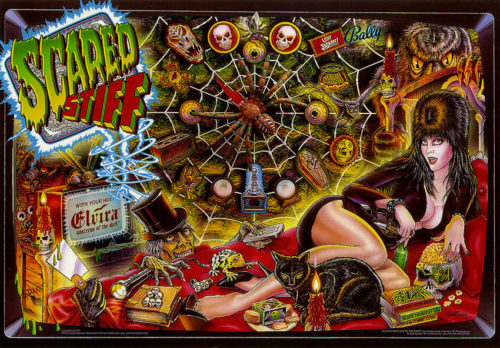 This macabre machine was also one of the most risque games ever made. The vocals are very suggestive as well as the theme of the game. The factory installed a family mode version to the game as well as a cover to the large breasts presented by Elvira on the back glass. Designed by Dennis Nordman and Mark Weyna, the art package came out of the mind of Greg Freres. The object of the game is to complete the six modes represented on the bottom of the playfield. Once all six modes are complete, the object then is to shoot the jackpots with two balls in play all the way up the stiff-o-meter. Doing so produces a pinball fireworks show of light as well as the flippers activating by themselves. The hardest feature on the game is represented in the back glass. If you can achieve all lights by stopping the spider on each and every stop displayed, a special spider multiball is activated. Happy Halloween!
This macabre machine was also one of the most risque games ever made. The vocals are very suggestive as well as the theme of the game. The factory installed a family mode version to the game as well as a cover to the large breasts presented by Elvira on the back glass. Designed by Dennis Nordman and Mark Weyna, the art package came out of the mind of Greg Freres. The object of the game is to complete the six modes represented on the bottom of the playfield. Once all six modes are complete, the object then is to shoot the jackpots with two balls in play all the way up the stiff-o-meter. Doing so produces a pinball fireworks show of light as well as the flippers activating by themselves. The hardest feature on the game is represented in the back glass. If you can achieve all lights by stopping the spider on each and every stop displayed, a special spider multiball is activated. Happy Halloween! -
